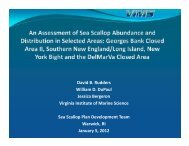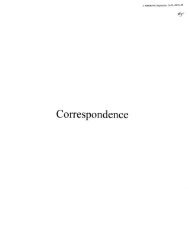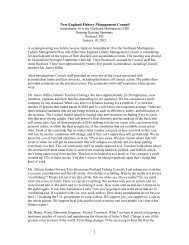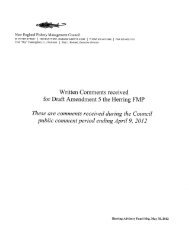Smooth Bottom Net Trawl Fishing Gear Effect on - New England ...
Smooth Bottom Net Trawl Fishing Gear Effect on - New England ...
Smooth Bottom Net Trawl Fishing Gear Effect on - New England ...
You also want an ePaper? Increase the reach of your titles
YUMPU automatically turns print PDFs into web optimized ePapers that Google loves.
NOAA/NMFS Unallied Science Project, Cooperative Agreement NA16FL2264 May 2005<br />
<str<strong>on</strong>g>Smooth</str<strong>on</strong>g> <str<strong>on</strong>g>Bottom</str<strong>on</strong>g> <str<strong>on</strong>g>Net</str<strong>on</strong>g> <str<strong>on</strong>g>Trawl</str<strong>on</strong>g> <str<strong>on</strong>g>Fishing</str<strong>on</strong>g> <str<strong>on</strong>g>Gear</str<strong>on</strong>g> <str<strong>on</strong>g>Effect</str<strong>on</strong>g> <strong>on</strong> the Seabed:<br />
Investigati<strong>on</strong> of Temporal and Cumulative <str<strong>on</strong>g>Effect</str<strong>on</strong>g>s BKAM/CR<br />
The sieved and preserved benthic infauna samples were transferred from formalin to alcohol and<br />
dyed with rose bengal (a protein dye) for presorting by the fishermen. During the 2001 NOAA<br />
trawl study, fishermen Frank Mirarchi and John Shea, and CR pers<strong>on</strong>nel Chris Wright and Chris<br />
Dunbar received training in benthic presorting by Allan Michael, Ph.D. Infauna were sorted into<br />
vials for crustacea, annelids, mollusks and miscellaneous organisms. Sediment residue was saved<br />
and checked by tax<strong>on</strong>omists at Allan Michael & Associates, Magnolia, MA. Infaunal samples<br />
were identified to the lowest practical tax<strong>on</strong>omic unit and the results for each sample entered into<br />
an Excel database as quantitative units. Grain size samples were also processed at Allan Michael<br />
& Associates lab. Percent gravel, sand, silt and clay, and the median grain size were determined<br />
for each sample <strong>on</strong> a dry weight basis.<br />
2.7 Sediment Profile Camera Methods<br />
SAIC and CR pers<strong>on</strong>nel performed sediment profile camera operati<strong>on</strong>s <strong>on</strong> August 1, October 10<br />
and November 12, 2002 aboard the F/V Christopher Andrew. The Benthos, Inc. Model 3731<br />
SPI system was used for the study. The system c<strong>on</strong>sists of a large stainless steel frame with lead<br />
weights, a prism and faceplate, a passive hydraulic pist<strong>on</strong>, and an electr<strong>on</strong>ics housing for a 35<br />
mm camera. The Benthos SPI camera system weighs approximately 1000 pounds and was<br />
deployed and recovered using the stern A-frame and trawl winch <strong>on</strong> the Christopher Andrew<br />
(Photograph 2.7-1).<br />
On each SPI cruise, the Ektachrome 35m film was developed <strong>on</strong>board the vessel using the E-6<br />
developing process to ensure that good photographs were obtained at all the sampling stati<strong>on</strong>s.<br />
At the Mud Hole and Little Tow sites, triplicate camera drops were performed at all 24 sampling<br />
stati<strong>on</strong>s al<strong>on</strong>g the c<strong>on</strong>trol (12 stati<strong>on</strong>s) and experimental trawl lanes (12 stati<strong>on</strong>s) for a total of 72<br />
images per survey effort. SPI images were analyzed by SAIC scientists, Ray Valente and<br />
Natasha Pinckard, and the results reviewed by D<strong>on</strong> Rhoads, Ph.D. Standard methods for the<br />
collecti<strong>on</strong> and analysis of the Remots sediment profile images are provided in Appendix 2.7-A.<br />
2.8 Video Sled Methods<br />
The video sled system c<strong>on</strong>sists of a lightweight aluminum frame that is equipped with a portable<br />
high resoluti<strong>on</strong> Deep Sea Power and Light color video camera, two Deep Sea Power and Light<br />
250 watt lights and a navigati<strong>on</strong> interface system. During the 2002 study, the sled was lowered to<br />
the bottom using an oceanographic winch equipped with a slip ring assembly and an armored<br />
communicati<strong>on</strong> cable (Photograph 2.8-1 a-c). Video images were m<strong>on</strong>itored throughout each<br />
transect and the amount of wire out was c<strong>on</strong>tinually adjusted to maintain optimum viewing<br />
distances. The video sled is a simple system that is fast and easy to mobilize and operate. This<br />
was particularly critical because the study design c<strong>on</strong>sisted of three cruises with a limited amount<br />
of ship time. The 2001 study utilized a combinati<strong>on</strong> of a Benthos Mini-Rover remote operated<br />
vehicle (ROV), and a video-sled run in both towed (1 to 2 knot speed) and drift (0.5 to 1 knot<br />
speed) modes. Of these methods, the ROV footage provided the best images of the impact of<br />
trawling <strong>on</strong> the seafloor, and the cross transect drifts were found to provide better quality video<br />
for discerning the physical impacts of the trawl gear. The video-sled drifts for this 2002 study<br />
were performed in an attempt to mimic the speed and height off the bottom of the ROV in the<br />
2001 study. With three separate cruises and <strong>on</strong>e day budgeted per cruise for video operati<strong>on</strong>s, the<br />
cost of using the ROV for the 2002 trawl study was not viable. Instead, CR’s underwater video<br />
sled was used to provide comparable underwater video coverage during the 2002 study.<br />
13







